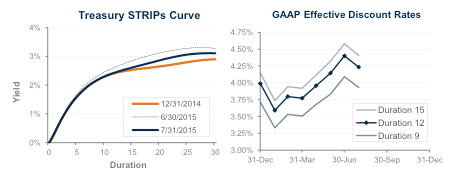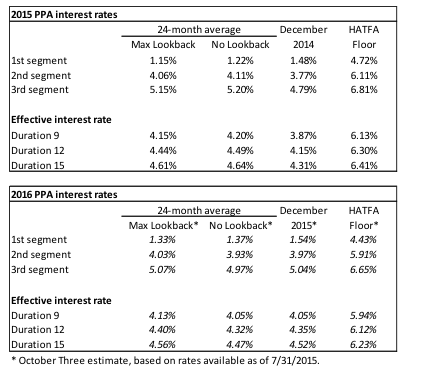July 2015 Pension Finance Update
as of July 31, 2015
Falling interest rates during July increased pension liabilities, producing losses during the month, although both model pension plans we track remain ahead for the year. Plan A lost 2% last month but remains up 5% for the year, while Plan B dropped 1% during July but remains up 2% so far in 2015.

Assets
Most varieties of stocks saw gains during July, with the S&P 500 adding 2%, the NASDAQ gaining almost 3%, and the overseas EAFE index growing by 2%, while the small-cap Russell 2000 lost 1% on the month. Year-to-date, the S&P 500 is up 3%, the NASDAQ has gained more than 8%, the Russell 2000 is ahead more than 3%, and the EAFE index is up more than 7%.
A diversified stock portfolio gained close to 2% in July and is now up 5% so far during 2015.
Bonds gained 1%-2% during July, due to interest rates falling about 0.15% during the month. For the year, a diversified bond portfolio is flat to up 1%, with short duration bonds performing best so far in 2015.
Overall, our traditional 60/40 portfolio gained 1%-2% in July and is now up 3%-4% for the year, while a conservative 20/80 portfolio also gained 1%-2% last month and is up 1% through July.
Liabilities
Both funding and accounting liabilities are now driven by market interest rates. The graph on the left compares Treasury STRIPs yields at December 31, 2014, and July 31, 2015, and also shows the movement in rates last month. The graph on the right shows our estimate of movements in effective GAAP discount rates for pension obligations of various duration during 2015 so far:

Interest rates moved down about 0.15% during July and are now about 0.25% higher than at the end of 2014. Last month’s move pushed pension liabilities up 2%, leaving them 1%-2% lower than at the end of 2014, with long duration plans seeing the biggest decreases.
Summary
So far, 2015 remains a year of modest gains for pension sponsors. Steady, incremental growth in stocks combined with somewhat higher interest rates have put most pension plans in the black through the first seven months of 2015:

Looking Ahead
Due to 2014 pension funding relief legislation (HATFA), pension funding requirements over the next few years will not be appreciably affected by current low interest rates (unless these rates persist for several years). Required contributions for 2015-2020 will be lower and more stable than under prior law.
The increase last month pushed rates to the highest level in over a year. Most pension sponsors are using rates of 3.7%-4.4% to measure pension liabilities for accounting purposes in today’s environment.
The table below summarizes rates that plan sponsors are required to use for IRS funding purposes for 2015, along with estimates for 2016. Pre-HATFA, both 24-month averages and December ‘spot’ rates, which are still required for some calculations, such as PBGC premiums, are also included.

1 Plan A is a traditional plan (duration 12 at 5.5%) with a 60/40 asset allocation, while Plan B is a cash balance plan (duration 9 at 5.5%) with a 20/80 allocation with a greater emphasis on corporate and long-duration bonds. For both plans, we assume the plan is 100% funded at the beginning of the year and ignore benefit accruals, contributions, and benefit payments in order to isolate the financial performance of plan assets versus liabilities.
